Latest Cisco Additional Online Exams for Validating Knowledge 200-125 dumps pdf practice questions and
study guiudes download free try from leads4pass. “Advanced Collaboration Architecture Sales Engineer” is the name
of Cisco Additional Online Exams for Validating Knowledge https://www.leads4pass.com/200-125.html exam dumps which
covers all the knowledge points of the real Cisco exam. You can download Cisco Additional Online Exams for
Validating Knowledge 200-125 dumps exam training material from leads4pass and pass the Cisco 200-125 exam in the first attempt.
Free ccna 200-125 dumps download from Google Drive:
https://drive.google.com/open?id=1hr-BNy3g5mhTzNb1En9MaHtay6KjqZ6R
Free CCNP Wireless 300-365 dumps download from Google Drive:
https://drive.google.com/open?id=1Vl3BcSbXnfokBm-tIiVaqcq7OR7m3ux-
Free leads4pass CCNA Cisco Certified Network Associate CCNA (v3.0) 200-125 exam dumps
QUESTION 1
Refer to the graphic

A static route to the 10.5.6.0/24 network is to be configured on the HFD router. Which commands will accomplish this? (Choose two.)
A. HFD(config)# ip route 10.5.6.0 0.0.0.255 fa0/0
B. HFD(config)# ip route 10.5.6.0 0.0.0.255 10.5.4.6
C. HFD(config)# ip route 10.5.6.0 255.255.255.0 fa0/0
D. HFD(config)# ip route 10.5.6.0 255.255.255.0 10.5.4.6
E. HFD(config)# ip route 10.5.4.6 0.0.0.255 10.5.6.0
F. HFD(config)# ip route 10.5.4.6 255.255.255.0 10.5.6.0
Correct Answer: CD
Explanation
Explanation/Reference:
The simple syntax of static route:
ip route destination-network-address subnet-mask {next-hop-IP-address | exit-interface} + destination-network-address: destination network address of the remote network + subnet mask: subnet mask of the destination network + next-hop-
IP-address: the IP address of the receiving interface on the next-hop router + exit-interface: the local interface of this router where the packets will go out In the statement “ip route 10.5.6.0 255.255.255.0 fa0/0:
+ 10.5.6.0 255.255.255.0: the destination network
+fa0/0: the exit-interface
QUESTION 2
Refer to the exhibit.

What is the effect of the configuration that is shown?
A. It configures SSH globally for all logins.
B. It tells the router or switch to try to establish an SSh connection first and if that fails to use Telnet.
C. It configures the virtual terminal lines with the password 030752180500.
D. It configures a Cisco network device to use the SSH protocol on incoming communications via the virtual terminal ports.
E. It allows seven failed login attempts before the VTY lines are temporarily shutdown.
Correct Answer: D
Explanation
Explanation/Reference:
Secure Shell (SSH) is a protocol which provides a secure remote access connection to network devices. Communication between the client and server is encrypted in both SSH version 1 and SSH version 2. If you want to prevent non-SSH
connections, add the “transport input ssh” command under the lines to limit the router to SSH connections only.
Straight (non-SSH) Telnets are refused.
Reference: www.cisco.com/warp/public/707/ssh.shtml
QUESTION 3
Which three elements must be used when you configure a router interface for VLAN trunking? (Choose three.)
A. one physical interface for each subinterface
B. one IP network or subnetwork for each subinterface
C. a management domain for each subinterface
D. subinterface encapsulation identifiers that match VLAN tags
E. one subinterface per VLAN
F. subinterface numbering that matches VLAN tags
Correct Answer: BDE
Explanation
Explanation/Reference:
This scenario is commonly called a router on a stick. A short, well written article on this operation can be found here:
http://www.thebryantadvantage.com/RouterOnAStickCCNACertificationExamTutorial.htm
QUESTION 4
Refer to the exhibit.

What can be determined about the router from the console output?
A. No configuration file was found in NVRAM.
B. No configuration file was found in flash.
C. No configuration file was found in the PCMCIA card.
D. Configuration file is normal and will load in 15 seconds.
Correct Answer: A
Explanation
Explanation/Reference:
When no startup configuration file is found in NVRAM, the System Configuration Dialog will appear to ask if we want to enter the initial configuration dialog or not.
QUESTION 5
What information does a router running a link-state protocol use to build and maintain its topological database? (Choose two.)
A. hello packets
B. SAP messages sent by other routers
C. LSAs from other routers
D. beacons received on point-to-point links
E. routing tables received from other link-state routers
F. TTL packets from designated routers
Correct Answer: AC
Explanation
Explanation/Reference:
Neighbor discovery is the first step in getting a link state environment up and running. In keeping with the friendly neighbor terminology, a Hello protocol is used for this step. The protocol will define a Hello packet format and a procedure for
exchanging the packets and processing the information the packets contain.
After the adjacencies are established, the routers may begin sending out LSAs. As the term flooding implies, the advertisements are sent to every neighbor. In turn, each received LSA is copied and forwarded to every neighbor except the one
that sent the LSA.
QUESTION 6
Refer to the exhibit.

The technician wants to upload a new IOS in the router while keeping the existing IOS. What is the maximum size of an IOS file that could be loaded if the original IOS is also kept in flash?
A. 3 MB
B. 4 MB
C. 5 MB
D. 7 MB
E. 8 MB
Correct Answer: B
Explanation
Explanation/Reference:
In this example, there are a total of 8 MB, but 3.8 are being used already, so another file as large as 4MB can be loaded in addition to the original file.
QUESTION 7
Which command displays CPU utilization?
A. show protocols
B. show process
C. show system
D. show version
Correct Answer: B
Explanation
Explanation/Reference:
The “show process” (in fact, the full command is “show processes”) command gives us lots of information about each process but in fact it is not easy to read. Below shows the output of this command (some next pages are omitted)

A more friendly way to check the CPU utilization is the command “show processes cpu history”, in which the total CPU usage on the router over a period of time: one minute, one hour, and 72 hours are clearly shown
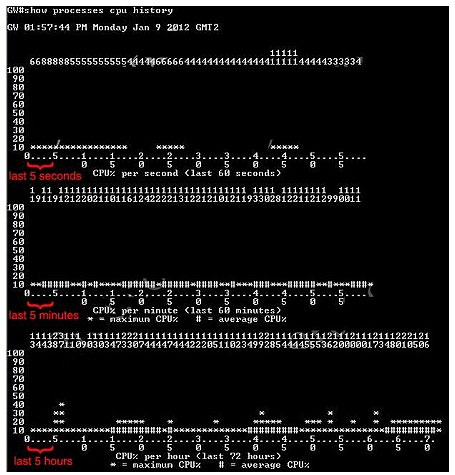
+ The Y-axis of the graph is the CPU utilization.
+ The X-axis of the graph is the increment within the period displayed in the graph. For example, from the last graph (last 72 hours) we learn that the highest CPU utilization within 72 hours is 37% about six hours ago.
QUESTION 8
A router has learned three possible routes that could be used to reach a destination network. One route is from EIGRP and has a composite metric of 20514560. Another route is from OSPF with a metric of 782. The last is from RIPv2 and
has a metric of 4. Which route or routes will the router install in the routing table?
A. the OSPF route
B. the EIGRP route
C. the RIPv2 route
D. all three routes
E. the OSPF and RIPv2 routes
Correct Answer: B
Explanation
Explanation/Reference:
When one route is advertised by more than one routing protocol, the router will choose to use the routing protocol which has lowest Administrative Distance. The Administrative Distances of popular routing protocols are listed below:
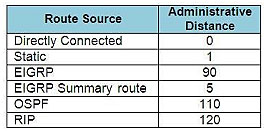
QUESTION 9
Refer to the exhibit.
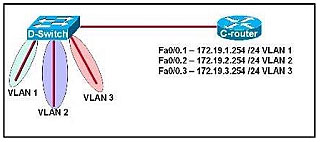
C-router is to be used as a “router-on-a-stick” to route between the VLANs. All the interfaces have been properly configured and IP routing is operational. The hosts in the VLANs have been configured with the appropriate default gateway.
What is true about this configuration?
A. These commands need to be added to the configuration:
C-router(config)# router eigrp 123
C-router(config-router)# network 172.19.0.0
B. These commands need to be added to the configuration:
C-router(config)# router ospf 1
C-router(config-router)# network 172.19.0.0 0.0.3.255 area 0
C. These commands need to be added to the configuration:
C-router(config)# router rip
C-router(config-router)# network 172.19.0.0
D. No further routing configuration is required.
Correct Answer: D
Explanation
Explanation/Reference:
Since all the same router (C-router) is the default gateway for all three VLANs, all traffic destined to a different VLA will be sent to the C-router. The C-router will have knowledge of all three networks since they will appear as directly
connected in the routing table. Since the C-router already knows how to get to all three networks, no routing protocols need to be configured.
QUESTION 10
If IP routing is enabled, which two commands set the gateway of last resort to the default gateway? (Choose two.)
A. ip default-gateway 0.0.0.0
B. ip route 172.16.2.1 0.0.0.0 0.0.0.0
C. ip default-network 0.0.0.0
D. ip default-route 0.0.0.0 0.0.0.0 172.16.2.1
E. ip route 0.0.0.0 0.0.0.0 172.16.2.1
Correct Answer: CE
Explanation
Explanation/Reference:
Both the “ip default-network” and “ip route 0.0.0.0 0.0.0.0 (next hop)” commands can be used to set the default gateway in a Cisco router.
QUESTION 11
Which two statements about the OSPF Router ID are true? (Choose two.)
A. It identifies the source of a Type 1 LSA.
B. It should be the same on all routers in an OSPF routing instance.
C. By default, the lowest IP address on the router becomes the OSPF Router ID.
D. The router automatically chooses the IP address of a loopback as the OSPF Router ID.
E. It is created using the MAC Address of the loopback interface.
Correct Answer: AD
Explanation
Explanation/Reference:
r120#show ip ospf data
OSPF Router with ID (10.0.0.120) (Process ID 1)
Next, who are the other routers in our area?
Router Link States (Area 1)
Link IDADV RouterAgeSeq#ChecksumLink count
10.0.0.11110.0.0.1116000x8000023A 0x0092B31
10.0.0.11210.0.0.11212460×80000234 0x009CAC1
10.0.0.11310.0.0.1131480x8000022C0x0043993
10.0.0.12010.0.0.1201520x800002400x0046CB1
We can see OSPF Router ID will be used as source of Type 1 LSA. Also the router will chose the highest loopback interface as its OSPF router ID (if available).
QUESTION 12
Refer to the exhibit

The speed of all serial links is E1 and the speed of all Ethernet links is 100 Mb/s. A static route will be established on the Manchester router to direct traffic toward the Internet over the most direct path available. What configuration on the
Manchester router will establish a route toward the Internet for traffic that originates from workstations on the Manchester LAN?
A. ip route 0.0.0.0 255.255.255.0 172.16.100.2
B. ip route 0.0.0.0 0.0.0.0 128.107.1.1
C. ip route 0.0.0.0 255.255.255.252 128.107.1.1
D. ip route 0.0.0.0 0.0.0.0 172.16.100.1
E. ip route 0.0.0.0 0.0.0.0 172.16.100.2
F. ip route 0.0.0.0 255.255.255.255 172.16.100.2
Correct Answer: E
Explanation
Explanation/Reference:
We use default routing to send packets with a remote destination network not in the routing table to the next-hop router. You should generally only use default routing on stub networks–those with only one exit path out of the network.
According to exhibit, all traffic towards Internet that originates from workstations should forward to Router R1.Syntax for default route is:
ip route <Remote_Network> <Netmask> <Next_Hop_Address>.
QUESTION 13
Which command reveals the last method used to powercycle a router?
A. show reload
B. show boot
C. show running-config
D. show version
Correct Answer: D
Explanation
Explanation/Reference:
The “show version” command can be used to show the last method to powercycle (reset) a router
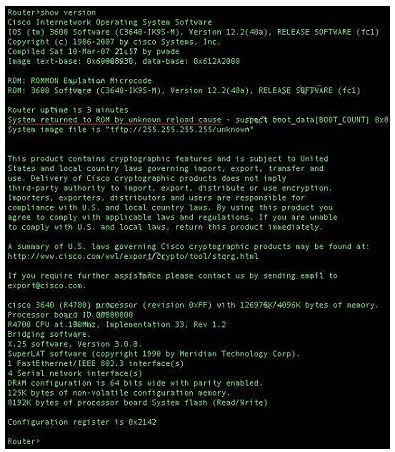
QUESTION 14
Why do large OSPF networks use a hierarchical design? (Choose three.)
A. to decrease latency by increasing bandwidth
B. to reduce routing overhead
C. to speed up convergence
D. to confine network instability to single areas of the network
E. to reduce the complexity of router configuration
F. to lower costs by replacing routers with distribution layer switches
Correct Answer: BCD
Explanation
Explanation/Reference:
OSPF implements a two-tier hierarchical routing model that uses a core or backbone tier known as area zero (0). Attached to that backbone via area border routers (ABRs) are a number of secondary tier areas. The hierarchical approach is
used to achieve the following:
Rapid convergence because of link and/or switch failures ?
Deterministic traffic recovery
?
Scalable and manageable routing hierarchy, reduced routing overhead.
QUESTION 15
Refer to the exhibit.
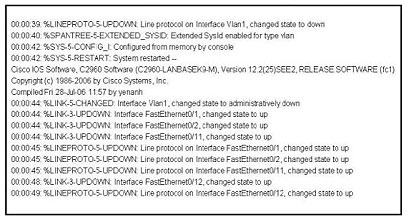
Which of these statements correctly describes the state of the switch once the boot process has been completed?
A. As FastEthernet0/12 will be the last to come up, it will be blocked by STP.
B. Remote access management of this switch will not be possible without configuration change.
C. More VLANs will need to be created for this switch.
D. The switch will need a different IOS code in order to support VLANs and STP.
Correct Answer: B
Explanation
Explanation/Reference:
Notice the line, which says “Interface VLAN1, changed state to administratively down”. This shows that VLAN1 is shut down. Hence remote management of this switch is not possible unless VLAN1 is brought back up. Since VLAN1 is the only
interface shown in the output, you have to assume that no other VLAN interface has been configured with an IP Address.
QUESTION 16
Refer to the exhibit.
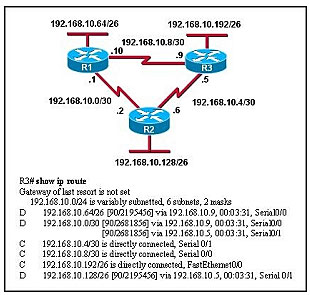
Based on the exhibited routing table, how will packets from a host within the 192.168.10.192/26 LAN be forwarded to 192.168.10.1?
A. The router will forward packets from R3 to R2 to R1.
B. The router will forward packets from R3 to R1 to R2.
C. The router will forward packets from R3 to R2 to R1 AND from R3 to R1.
D. The router will forward packets from R3 to R1.
Correct Answer: C
Explanation
Explanation/Reference:
From the routing table we learn that network 192.168.10.0/30 is learned via 2 equal-cost paths (192.168.10.9 &192.168.10.5) -> traffic to this network will be load-balancing.
QUESTION 17
What are two enhancements that OSPFv3 supports over OSPFv2? (Choose two.)
A. It requires the use of ARP.
B. It can support multiple IPv6 subnets on a single link.
C. It supports up to 2 instances of OSPFv3 over a common link.
D. It routes over links rather than over networks.
Correct Answer: BD
Explanation
Explanation/Reference:
Here is a list of the differences between OSPFv2 and OSPFv3:
They use different address families (OSPFv2 is for IPv4-only, OSPFv3 can be used for IPv6-only or both protocols
OSPFv3 introduces new LSA types
OSPFv3 has different packet format
OSPFv3 uses different flooding scope bits (U/S2/S1) OSPFv3 adjacencies are formed over link-local IPv6 communications OSPFv3 runs per-link rather than per-subnet
OSPFv3 supports multiple instances on a single link, Interfaces can have multiple IPv6 addresses
OSPFv3 uses multicast addresses FF02::5 (all OSPF routers), FF02::6 (all OSPF DRs)
OSPFv3 Neighbor Authentication done with IPsec (AH) OSPFv2 Router ID (RID) must be manually configured, still a 32-bit number
Reference: http://www.networkworld.com/article/2225270/cisco-subnet/ospfv3-for-ipv4-and- ipv6.html
QUESTION 18
Refer to the exhibit.
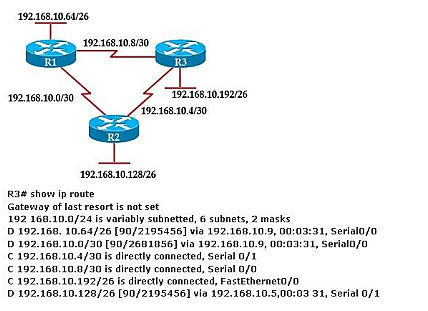
The company uses EIGRP as the routing protocol. What path will packets take from a host on the 192.168.10.192/26 network to a host on the LAN attached to router R1?
A. The path of the packets will be R3 to R2 to R1.
B. The path of the packets will be R3 to R1 to R2.
C. The path of the packets will be both R3 to R2 to R1 AND R3 to R1.
D. The path of the packets will be R3 to R1.
Correct Answer: D
Explanation
Explanation/Reference:
Host on the LAN attached to router R1 belongs to 192.168.10.64/26 subnet. From the output of the routing table of R3 we learn this network can be reach via 192.168.10.9, which is an IP address in 192.168.10.8/30 network (the network
between R1 & R3) -> packets destined for 192.168.10.64 will be routed from R3 -> R1 -> LAN on R1.
QUESTION 19
A Cisco router is booting and has just completed the POST process. It is now ready to find and load an IOS image. What function does the router perform next?
A. It checks the configuration register.
B. It attempts to boot from a TFTP server.
C. It loads the first image file in flash memory.
D. It inspects the configuration file in NVRAM for boot instructions.
Correct Answer: A
Explanation
Explanation/Reference:
Default (normal) Boot Sequence
Power on Router – Router does POST – Bootstrap starts IOS load – Check configuration register to see what mode the router should boot up in (usually 0x2102 to read startup- config in NVRAM / or 0x2142 to start in “setup-mode”) – check the
startup-config file in NVRAM for boot-system commands – load IOS from Flash.
QUESTION 20
Refer to the exhibit
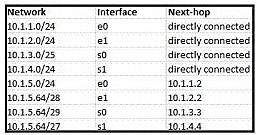
According to the routing table, where will the router send a packet destined for 10.1.5.65?
A. 10.1.1.2
B. 10.1.2.2
C. 10.1.3.3
D. 10.1.4.4
Correct Answer: C
Explanation
Explanation/Reference:
The destination IP address 10.1.5.65 belongs to 10.1.5.64/28, 10.1.5.64/29 & 10.1.5.64/27 subnets but the “longest prefix match” algorithm will choose the most specific subnet mask -> the prefix “/29 will be chosen to route the packet.
Therefore the next-hop should be 10.1.3.3 ->.
QUESTION 21
Which parameter would you tune to affect the selection of a static route as a backup, when a dynamic protocol is also being used?
A. hop count
B. administrative distance
C. link bandwidth
D. link delay
E. link cost
Correct Answer: B
Explanation
Explanation/Reference:
By default the administrative distance of a static route is 1, meaning it will be preferred over all dynamic routing protocols. If you want to have the dynamic routing protocol used and have the static route be used only as a backup, you need to
increase the AD of the static route so that it is higher than the dynamic routing protocol.
QUESTION 22
Which command would you configure globally on a Cisco router that would allow you to view directly connected Cisco devices?
A. enable cdp
B. cdp enable
C. cdp run
D. run cdp
Correct Answer: C
Explanation
Explanation/Reference:
CDP is enabled on Cisco routers by default. If you prefer not to use the CDP capability, disable it with the no cdp run command. In order to reenable CDP, use the cdp run command in global configuration mode. The “cdp enable” command is
an interface command, not global.
QUESTION 23
Which parameter or parameters are used to calculate OSPF cost in Cisco routers?
A. Bandwidth
B. Bandwidth and Delay
C. Bandwidth, Delay, and MTU
D. Bandwidth, MTU, Reliability, Delay, and Load
Correct Answer: A
Explanation
Explanation/Reference:
The well-known formula to calculate OSPF cost is
Cost = 108 / Bandwidth
QUESTION 24
Refer to the graphic
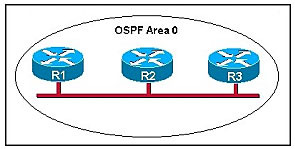
R1 is unable to establish an OSPF neighbor relationship with R3. What are possible reasons for this problem? (Choose two.)
A. All of the routers need to be configured for backbone Area 1.
B. R1 and R2 are the DR and BDR, so OSPF will not establish neighbor adjacency with R3.
C. A static route has been configured from R1 to R3 and prevents the neighbor adjacency from being established.
D. The hello and dead interval timers are not set to the same values on R1 and R3.
E. EIGRP is also configured on these routers with a lower administrative distance.
F. R1 and R3 are configured in different areas.
Correct Answer: DF
Explanation
Explanation/Reference:
This question is to examine the conditions for OSPF to create neighborhood. So as to make the two routers become neighbors, each router must be matched with the following items:
1. The area ID and its types;
2. Hello and failure time interval timer;
3. OSPF Password (Optional).
QUESTION 25
Refer to the exhibit.

A network administrator configures a new router and enters the copy startup-config running-config command on the router. The network administrator powers down the router and sets it up at a remote location. When the router starts, it enters
the system configuration dialog as shown. What is the cause of the problem?
A. The network administrator failed to save the configuration.
B. The configuration register is set to 0x2100.
C. The boot system flash command is missing from the configuration.
D. The configuration register is set to 0x2102.
E. The router is configured with the boot system startup command.Correct Answer: A
Explanation
Explanation/Reference:
The “System Configuration Dialog” appears only when no startup configuration file is found. The network administrator has made a mistake because the command “copy startup-config running-config” will copy the startup config (which is
empty) over the running config (which is configured by the administrator). So everything configured was deleted. Note: We can tell the router to ignore the start-up configuration on the next reload by setting the register to 0?142. This will make
the “System Configuration Dialog” appear at the next reload.
QUESTION 26
On a corporate network, hosts on the same VLAN can communicate with each other, but they are unable to communicate with hosts on different VLANs. What is needed to allow communication between the VLANs?
A. a router with subinterfaces configured on the physical interface that is connected to the switch
B. a router with an IP address on the physical interface connected to the switch
C. a switch with an access link that is configured between the switches
D. a switch with a trunk link that is configured between the switches
Correct Answer: A
Explanation
Explanation/Reference:
Different VLANs can’t communicate with each other, they can communicate with the help of Layer3 router. Hence, it is needed to connect a router to a switch, then make the sub- interface on the router to connect to the switch, establishing
Trunking links to achieve communications of devices which belong to different VLANs.
When using VLANs in networks that have multiple interconnected switches, you need to use VLAN trunking between the switches. With VLAN trunking, the switches tag each frame sent between switches so that the receiving switch knows to
what VLAN the frame belongs. End user devices connect to switch ports that provide simple connectivity to a single VLAN each. The attached devices are unaware of any VLAN structure.
By default, only hosts that are members of the same VLAN can communicate. To change this and allow inter-VLAN communication, you need a router or a layer 3 switch.
Here is the example of configuring the router for inter-vlan communication RouterA(config)#int f0/0.1
RouterA(config-subif)#encapsulation ?
dot1Q IEEE 802.1Q Virtual LAN
RouterA(config-subif)#encapsulation dot1Q or isl VLAN ID RouterA(config-subif)# ip address x.x.x.x y.y.y.y
QUESTION 27
Which command would you use on a Cisco router to verify the Layer 3 path to a host?
A. tracert address
B. traceroute address
C. telnet address
D. ssh address
Correct Answer: B
Explanation
Explanation/Reference:
In computing, traceroute is a computer network diagnostic tool for displaying the route (path) and measuring transit delays of packets across an Internet Protocol (IP) network. The history of the route is recorded as the round-trip times of the
packets received from each successive host (remote node) in the route (path); the sum of the mean times in each hop indicates the total time spent to establish the connection. Traceroute proceeds unless all (three) sent packets are lost more
than twice, then the connection is lost and the route cannot be evaluated. Ping, on the other hand, only computes the final round-trip times from the destination point.
QUESTION 28
The network administrator cannot connect to Switch1 over a Telnet session, although the hosts attached to Switch1 can ping the interface Fa0/0 of the router
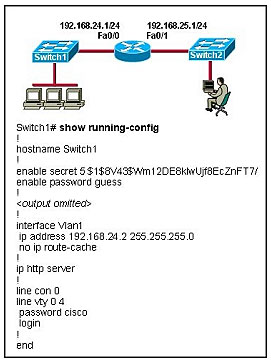
Given the information in the graphic and assuming that the router and Switch2 are configured properly, which of the following commands should be issued on Switch1 to correct this problem?
A. Switch1(config)# line con0
Switch1(config-line)# password cisco
Switch1(config-line)#login
B. Switch1(config)# interface fa0/1
Switch1(config-if)# ip address 192.168.24.3 255.255.255.0
C. Switch1(config)# ip default-gateway 192.168.24.1
D. Switch1(config)# interface fa0/1
Switch1(config-if)# duplex full
Switch1(config-if)# speed 100
E. Switch1(config)# interface fa0/1
Switch1(config-if)# switchport mode trunk
Correct Answer: C
Explanation
Explanation/Reference:
Since we know hosts can reach the router through the switch, we know that connectivity, duplex. Speed, etc. are good. However, for the switch itself to reach networks outside the local one, the ip default-gateway command must be used.
QUESTION 29
Which statements describe the routing protocol OSPF? (Choose three.)
A. It supports VLSM.
B. It is used to route between autonomous systems.
C. It confines network instability to one area of the network.
D. It increases routing overhead on the network.
E. It allows extensive control of routing updates.
F. It is simpler to configure than RIP v2.
Correct Answer: ACE
Explanation
Explanation/Reference:
The OSPF protocol is based on link-state technology, which is a departure from the Bellman-Ford vector based algorithms used in traditional Internet routing protocols such as RIP. OSPF has introduced new concepts such as authentication
of routing updates, Variable Length Subnet Masks (VLSM), route summarization, and so forth. OSPF uses flooding to exchange link-state updates between routers. Any change in routing information is flooded to all routers in the network.
Areas are introduced to put a boundary on the explosion of link-state updates. Flooding and calculation of the Dijkstra algorithm on a router is limited to changes within an area.
QUESTION 30
A network administrator needs to allow only one Telnet connection to a router. For anyone viewing the configuration and issuing the show run command, the password for Telnet access should be encrypted. Which set of commands will
accomplish this task?
A. service password-encryption
access-list 1 permit 192.168.1.0 0.0.0.255
line vty 0 4
loginpassword cisco
access-class 1
B. enable password secret
line vty 0
login
password cisco
C. service password-encryption
line vty 1
login
password cisco
D. service password-encryption
line vty 0 4
login
password cisco
Correct Answer: C
Explanation
Explanation/Reference:
Only one VTY connection is allowed which is exactly what’s requested.
Incorrect answer: command.
line vty0 4
would enable all 5 vty connections.
QUESTION 31
What is the default administrative distance of OSPF?
A. 90
B. 100
C. 110
D. 120
Correct Answer: C
Explanation
Explanation/Reference:
Administrative distance is the feature that routers use in order to select the best path when there are two or more different routes to the same destination from two different routing protocols. Administrative distance defines the reliability of a
routing protocol. Each routing protocol is prioritized in order of most to least reliable (believable) with the help of an administrative distance value.
Default Distance Value Table
This table lists the administrative distance default values of the protocols that Cisco supports:
Route Source
Default Distance Values
Connected interface
Static route
Enhanced Interior Gateway Routing Protocol (EIGRP) summary route External Border Gateway Protocol (BGP)
Internal EIGRP
IGRP
OSPF
Intermediate System-to-Intermediate System (IS-IS) Routing Information Protocol (RIP)
Exterior Gateway Protocol (EGP)
On Demand Routing (ODR)
External EIGRP
Internal BGP
Unknown*
QUESTION 32
Refer to the exhibit.
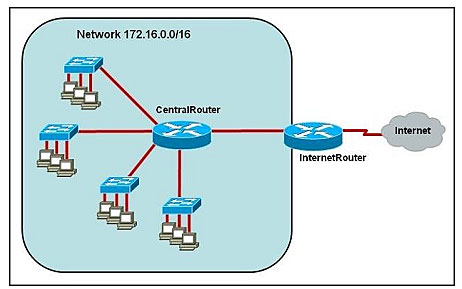
The network administrator requires easy configuration options and minimal routing protocol traffic. What two options provide adequate routing table information for traffic that passes between the two routers and satisfy the requests of the
network administrator? (Choose two.)
A. a dynamic routing protocol on InternetRouter to advertise all routes to CentralRouter.
B. a dynamic routing protocol on InternetRouter to advertise summarized routes to CentralRouter.
C. a static route on InternetRouter to direct traffic that is destined for 172.16.0.0/16 to CentralRouter.
D. a dynamic routing protocol on CentralRouter to advertise all routes to InternetRouter.
E. a dynamic routing protocol on CentralRouter to advertise summarized routes to InternetRouter.
F. a static, default route on CentralRouter that directs traffic to InternetRouter.
Correct Answer: CF
Explanation
Explanation/Reference:
The use of static routes will provide the necessary information for connectivity while producing no routing traffic overhead.
QUESTION 33
Refer to the exhibit

What is the reason that the interface status is “administratively down, line protocol down”?
A. There is no encapsulation type configured.
B. There is a mismatch in encapsulation types.
C. The interface is not receiving any keepalives.
D. The interface has been configured with the shutdown command.
E. The interface needs to be configured as a DTE device.
F. The wrong type of cable is connected to the interface.
Correct Answer: D
Explanation
Explanation/Reference:
Interfaces can be enabled or disabled with shutdown/no shutdown command. If you interface is down, it will display administratively down status. You can bring up an interface having administratively down interface using no shutdown
command.
QUESTION 34
Drag each definition on the left to the matching term on the right.
Select and Place
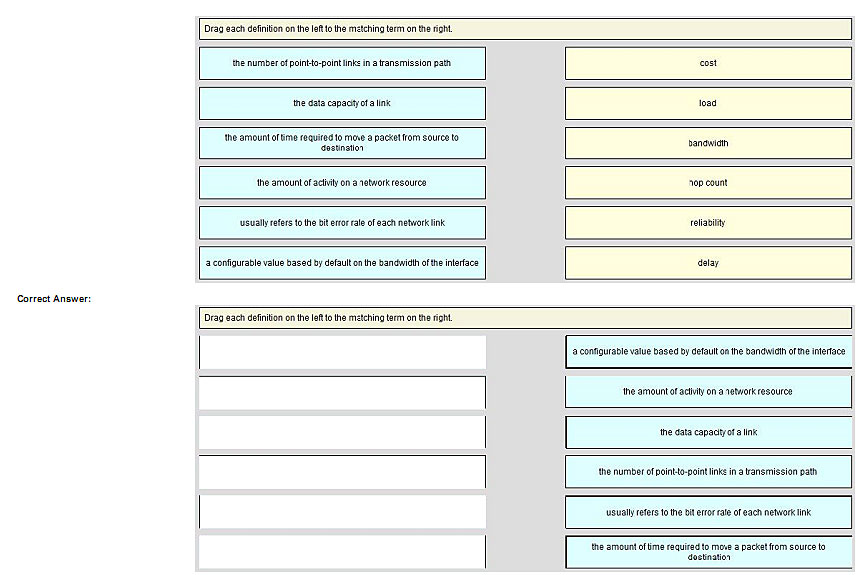
Explanation
Explanation/Reference:
QUESTION 35
Drag the Cisco default administrative distance to the appropriate routing protocol or route. (Not all options are used.)
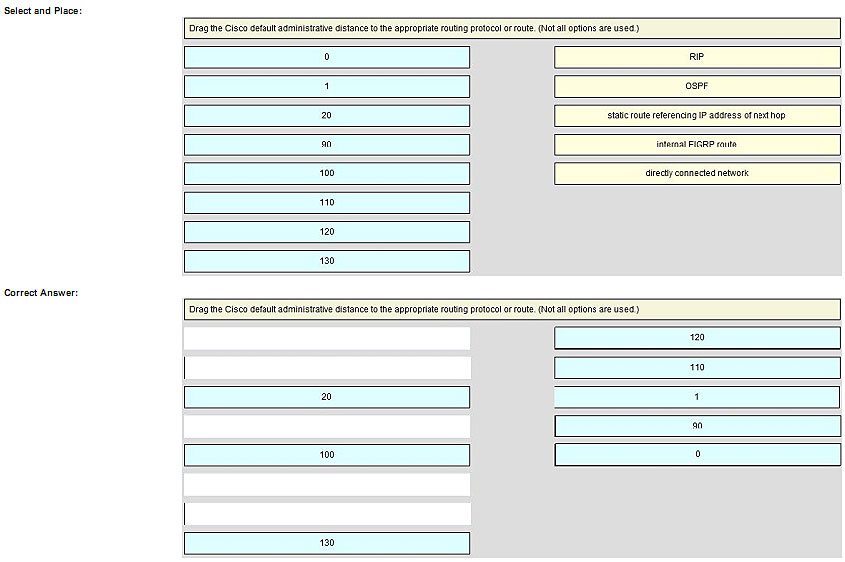
Explanation
Explanation/Reference:
QUESTION 36
Routing has been configured on the local router with these commands:
Local(config)# ip route 0.0.0.0 0.0.0.0 192.168.1.1
Local(config)# ip route 10.1.0.0 255.255.255.0 192.168.2.2
Local(config)# ip route 10.1.0.0 255.255.0.0 192.168.3.3
Drag each destination IP address on the left to its correct next hop address on the right.
Select and Place:
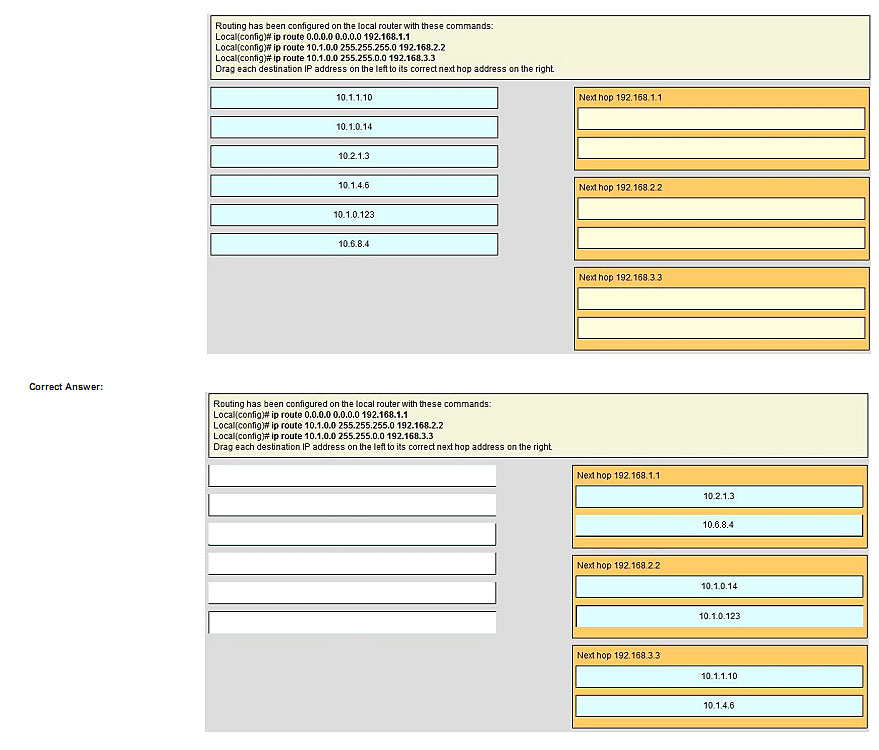
Explanation
Explanation/Reference:
If we have many entries matching for next hop ip address then the router will choose the one with most specific path to send the packet. This is called the “longest match” rule, the route with the most bits in the mask set to “1 will be chosen to
route packet.
Get the latest Cisco Additional Online Exams for Validating Knowledge 200-125 dumps exam learning materials in pdf format
download free try from leads4pass. New Cisco Additional Online Exams for Validating Knowledge https://www.leads4pass.com/200-125.html
dumps pdf training resources which are the best for clearing 200-125 exam test, and to get certified by Cisco Additional Online Exams for Validating Knowledge.
p.s. Free ccna 200-125 dumps download from Google Drive:
https://drive.google.com/open?id=1hr-BNy3g5mhTzNb1En9MaHtay6KjqZ6R
p.s. Free CCNP Wireless 300-365 dumps download from Google Drive:
https://drive.google.com/open?id=1Vl3BcSbXnfokBm-tIiVaqcq7OR7m3ux-
Why choose leads4pass?

related: https://www.micvce.com/new-cisco-ccnp-collaboration-300-070-dumps/